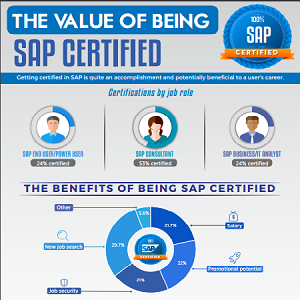Increasing Your Productivity: Finishing What You Started
by Elvira Veksler
 Productivity is kind of a big deal. Without it, we get nowhere fast.
Productivity is kind of a big deal. Without it, we get nowhere fast.
The reasons for not beginning a task tend to be forceful and endless: there’s no time, it’s not the right time, I haven’t been keeping track of the time, etc. And we, as humans (even those teaching SAP training), are naturally inclined to want to do, well, nothing. We want to relax, put our feet up, and maybe catch up on our favorite series.
The problem is we also need to grow ourselves and our companies. And besides, growth feels good.
Netflix will be there once we’re done being productive. And once we do the things we need to do, we actually LESSEN stress while increasing our skill sets (and earning potentials). In fact, we are able to enjoy that latest Game of Thrones episode even more - without the queasy feeling.
Indeed, there is more to life than SAP skills, or even taking SAP training courses. But productivity is also a part of life.
So how can I make productivity work for me?
We took to the experts to answer this age-old question.
A recent New York Times article revealed that one of the biggest mistakes we make when beginning to address productivity is thinking of it in terms of time management rather than attention management. In fact, “time management” is part of the problem – not the solution, according to the article.
“We live in a culture obsessed with personal productivity. We devour books on getting things done and dream of four-hour workweeks. We worship at the altar of hustle and boast about being busy. The key to getting things done, we’re often told, is time management. If you could just plan your schedule better, you could reach productivity nirvana,” reporter Adam Grant wrote.
Instead of relentlessly asking yourself how to get more done, you can begin to ask yourself, “What are my priorities? What matters?”
“In my research, I’ve found that productive people don’t agonize about which desire to pursue. They go after both simultaneously, gravitating toward projects that are personally interesting and socially meaningful,” according to Grant.
The key is in the why. What would doing the task do for you?
To take this one step farther, we asked Australia-based business coach Anthony English what he thought.
“Work out of love, not fear. Focus on the opportunities instead of the risks,” he said.
Work out of love, not fear. Focus on the opportunities instead of the risks.
Take breaks, water your plants, and focus on what the task can do for you.
What are some actual things I can do to increase my productivity?
So, what are some concrete things you can actually do? Here’s a list we made.
- Listen to music: We suggest throwing the “no headphones at work” rule out the window. In fact, many studies, like this one led by assistant professor in the music therapy program at the University of Miami Teresa Lesiuk, have shown that listening to music helps increase creativity, productivity, and mood.
- Exercise: Exercising has been shown to improve employee performance, concentration, finishing work on time, working without unscheduled breaks, and feeling motivated, according to a study by Bristol University.
- Sleep well: A lack of sleep leads to serious productivity losses, with sleep-deprived employees spending nearly three times as much time on time management, according to a 2010 study by Mark R. Rosekind, Ph.D., Kevin B. Gregory, BS, Melissa M. Mallis, Ph.D., Summer L. Brandt, MA, Brian Seal, Ph.D., and Debra Lerner, Ph.D. The study went on to say that sleep-deprived employees suffered a lack of motivation and focus and had trouble remembering things as well as making good decisions. Seven to eight hours of sleep is recommended and getting less has serious detriments to productivity.
- Take breaks: Taking breaks actually increases performance so don’t forget to take them throughout your day. A 2018 survey by Tork found that breaks were essential for employees to recharge for the rest of the workday and also improved overall job satisfaction.
- Take it “one step” at a time: Multitasking has been proven to be bad for your performance and doing one thing at a time actually helps you get more done. Research from the American Psychological Association revealed that individuals who try to perform more than one task at a time are not successful and that the brain was “not designed for heavy-duty multitasking,” likening it to air-traffic control, in which mental overload can lead to catastrophe.
A quick exercise for when you feel stuck
- Realize your mind is tricking you. No one spends all their time doing things. Our brains are WIRED to want to avoid doing that and that’s OK. Once we accept this, it takes a lot of the pressure off and life becomes a lot easier. There is NOTHING wrong with you for wanting to do nothing.
- Sadly, doing nothing produces a lot of bad results. So the next step here is to do something. Do one small thing, then take a break if you have to. Simply doing one small thing and then telling yourself you’re proud of yourself (as you should be – most people haven’t even done that!) has a lot of power.
- Do one more small thing after that. There, now that’s TWO small things. You are really getting places now.
- Now, do one big thing. Yes, it’s unpleasant to do a big thing. But at this point, you’ve already done two small things. Keep it rolling and get something big done. A well-deserved break is coming soon.
- When you don't feel like doing something you should probably do, gently ask yourself why that is. It is usually because you're afraid of failing. What we do at Michael Management is write down the negative thoughts associated with the task and the subsequent feelings (anxiety, hopelessness, depression, anger, guilt, etc.) because simply acknowledging a feeling helps take away its power. Finally, we write down a new, more balancing thought that includes our motivation for doing the task (i.e. I will feel more balanced once I do this).
So how does a company decide whether or not to take on SAP training?
We made a (simple) template!
Step 1: Research the SAP skills you think would be helpful for your company to know by visiting our course library page. What SAP training options are currently available and which ones could your company improve on to raise ROIs?
You can also get a free copy of our MMC SAP training survey, which summarizes information and opinions by 865 SAP professionals and discusses how the SAP training market is doing.
Step 2: Consider your finances. If you know the budget is particularly tight right now, reach out to us so we can create a solution that works within your budget. Or begin by training fewer people and expand the training program later you’re your budget opens up.
Step 3: If you’re ready to take the plunge into SAP training, you can register for a free account (and preview all Michael Management courses) or sign up for a free corporate trial. Here’s a free SAP cheat sheet you can download and a previous Michael Management blog entitled “Roadmap to Successful SAP Training” too.
Conclusion
SAP training can help you and your company increases productivity as well as ROIs. Coupled with putting productivity management at the top of your priority list, you can create the foundation to catapult your company into new areas and heights that simply haven’t been seen before.
by Elvira Veksler
More Blogs by Elvira Veksler


5 Ways How Technology Affects The Learning Industry
Technological disruption is affecting nearly every industry right now,...
Related Blogs

How to Convince Your Boss You Need SAP Training
If only you could make all the SAP training decisions at work! Fo...

The Value of Certifications in SAP
Knowing how to use SAP is a great advantage in your job and in your ca...

How To Deal With Training Overload
Online education has expanded exponentially since the 2000s, fueled by digital...
.png)

